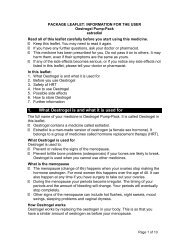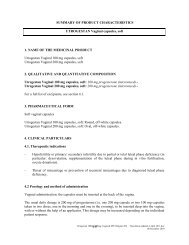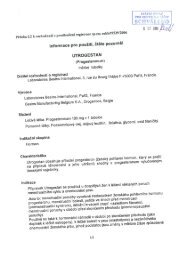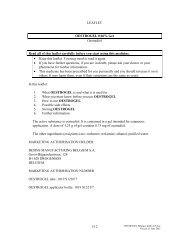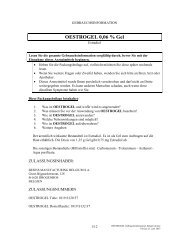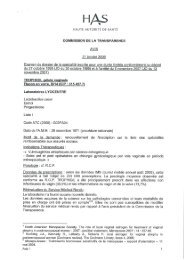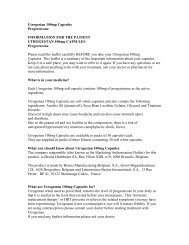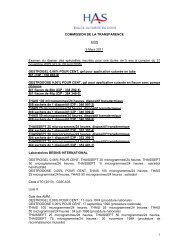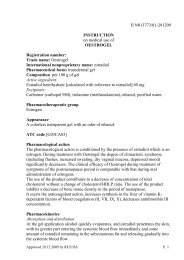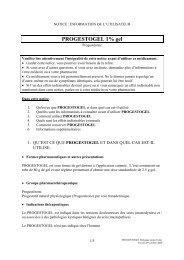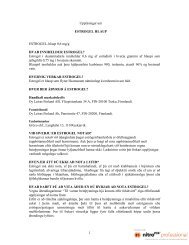Femigel Patient Information Leaflet (Ukraine) - Besins Healthcare
Femigel Patient Information Leaflet (Ukraine) - Besins Healthcare
Femigel Patient Information Leaflet (Ukraine) - Besins Healthcare
- No tags were found...
Create successful ePaper yourself
Turn your PDF publications into a flip-book with our unique Google optimized e-Paper software.
INSTRUCTION<br />
on medical use of<br />
OESTROGEL<br />
Composition:<br />
active ingredient: estradiol;<br />
1 g of gel contains 0.6 mg of estradiol (as estradiol hemihydrate);<br />
excipients: carbomer 980, triethanolamine, 96% ethanol, purified water.<br />
Each dose of the applicator corresponds to 2.5 g of gel or 1.5 mg of estradiol.<br />
Pharmaceutical form.<br />
Gel for local application.<br />
Pharmaceutical group.<br />
Estrogens. Simple preparations of natural and semisynthetic estrogens.<br />
ATC code G03С A03.<br />
Clinical characteristics.<br />
Indications.<br />
The symptoms related to deficiency of estrogens during age-related or artificial<br />
menopause, for prevention of osteoporosis.<br />
Contraindications.<br />
History of increased sensitivity to the active ingredient or excipients.<br />
Breast cancer (diagnosed, suspected or history thereof).<br />
Diagnosed or suspected estrogen-dependent malignant tumors (e.g., endometrium<br />
cancer).<br />
Vaginal bleedings of non-established etiology.<br />
Untreated endometrial hyperplasia.<br />
Current or history of thromboembolic diseases of the veins (deep vein thrombosis<br />
(DVT), pulmonary artery embolism).<br />
Current or history of acute thromboembolism of the arteries (e.g., angina pectoris,<br />
myocardial infarction).<br />
Current or history of severe liver impairment (before normalization of laboratory<br />
parameters of the liver function).<br />
Porphyria.<br />
Administration and dosage.<br />
Approved 23.03.2011 by UKR HA P. 1
Oestrogel is administered by cycles of 24-28 days per month. Doses and duration<br />
of treatment are determined by the doctor individually.<br />
One dose (2.5 g of gel) is applied in a thin layer on a large area of the skin: of the<br />
abdomen, low back, hips, shoulders and arms until complete absorption once daily.<br />
Usually 2.5 g of gel per day are used. If necessary, after 2-3 cycles the dose may be<br />
adjusted in accordance with the clinical signs of excess or deficiency estrogens<br />
(see section "Side reactions"). At the end of each therapeutical cycle menstruationlike<br />
bleedings of withdrawal are possible to occur.<br />
Administration<br />
1 dose of the applicator corresponds to 2.5 g of gel or 1.5 mg of estradiol<br />
hemihydrate.<br />
The gel is applied by the patient herself. For use open the tube and punch it with a<br />
small puncheon located in the stopper. The metal membrane of the tube must be<br />
fully opened. Use a plastic applicator-dispenser for measuring a daily dose. Press<br />
the tube above the spatula ruler. 1 dose is equal to a column (the diameter of a<br />
pencil), the length of which coincides with an indent on the ruler. The indent has a<br />
score which allows to divide the daily dose in 2 parts. One tube contains 30 doses.<br />
The gel should be applied with a thin layer in the above specified areas. Do not<br />
massage the site of the gel application. The gel contact with the breasts and<br />
mucosae should be avoided. Application is considered to be correct if the gel is<br />
absorbed completely within 2-3 minutes.<br />
Side reactions.<br />
As a rule, side reactions are poorly pronounced and require discontinuation of<br />
treatment very rarely. Side reactions usually occur only in the first months of<br />
treatment.<br />
Disorders of metabolism: edemas, an increase of body mass.<br />
Psychic disturbances: changes in mood and disorders of libido.<br />
Nervous system: headache, migraine.<br />
Cardiovascular system: an increase of blood pressure, venous thromboembolism.<br />
Digestive tract: nausea, vomiting, gastric colic, liver dysfunction and disorders of<br />
bile outflow.<br />
Skin: eruptions.<br />
Reproductive system: irregular vaginal bleedings or discharges.<br />
Neoplasms in the breasts: breast cancer.<br />
Reactions at the site of application: skin irritation.<br />
Approved 23.03.2011 by UKR HA P. 2
Below side effects are given which require the dose adjustment depending on signs<br />
of deficiency or increased amount of estrogens:<br />
signs of estrogen deficiency: flushes, frequent headache, migraine, dryness of the<br />
vagina, irritation of the eyes during the use of contact lenses;<br />
signs of excessive amount of estrogens: nausea, vomiting, abdominal gripes,<br />
flatulence, swelling of the breasts, irritability, edemas, heaviness of the legs,<br />
increased secretions from the uterine cervix.<br />
Other possible side effects: uterine bleedings (it is necessary to determine the<br />
cause, including endometriosis), galactorrhea (examination is necessary to exclude<br />
adenoma of the pituitary body), exacerbation of epilepsy, chloasma or melanosis.<br />
Overdose.<br />
In case of overdose the events specified in the section "Side reactions" (signs of<br />
excessive amount of estrogens) may occur. These symptoms disappear at<br />
discontinuation of the treatment or reduction of the dose.<br />
Use during pregnancy or breast feeding.<br />
The product may not be used during pregnancy and breast feeding. Treatment with<br />
Oestrogel should be immediately discontinued if pregnancy is confirmed or<br />
suspected. The data of epidemiological studies have not confirmed an additional<br />
risk of occurrence of congenital defects of the fetus due to the use of estrogen at<br />
the early stages of pregnancy in case of its late diagnosis. At the same time, it<br />
should be noted that it is not required to terminate pregnancy artificially in women<br />
taking estrogens or estroprogestagens at the early stages of pregnancy in case of its<br />
late diagnosis.<br />
Children. The product is not used in pediatric practice.<br />
Approved 23.03.2011 by UKR HA P. 3
Usage specifics.<br />
Before the beginning or before the repeated administration of hormone<br />
replacement therapy (HRT) the physician should record complete individual and<br />
family history of the female patient, to perform medical examination (including the<br />
organs of the small pelvis and breasts) with the purpose of revealing possible<br />
contraindications and taking necessary precautions at administration of the<br />
product.<br />
During treatment it is recommended to perform regular examinations. The<br />
frequency and methods of examinations are selected individually for each patient.<br />
Women should be informed that they should inform the doctor about changes in<br />
the breasts. Studies, including mammography, should be conducted in compliance<br />
with the accepted norms and be adapted to the individual clinical needs of each<br />
patient.<br />
If any of the below conditions occurs, took place before and/or aggravated during<br />
pregnancy or preliminary hormone therapy, the patient must be under permanent<br />
monitoring of the doctor. These conditions in some cases can recur or aggravate<br />
during treatment with Oestrogel, in particular, leiomyoma (fybromyoma) of the<br />
uterus or endometriosis in case of the history of these conditions, the factors of risk<br />
of estrogen-dependent tumors (e.g., degree I of hereditary breast cancer), arterial<br />
hypertension, mild or moderate liver diseases and hepatic adenoma, diabetes<br />
mellitus with or without lesions of vessels, cholelithiasis, migraine, systemic lupus<br />
erythematosus, epilepsy, bronchial asthma, otosclerosis.<br />
The therapy should be discontinued at the occurrence of the following conditions:<br />
jaundice or severe liver dysfunctions, a considerable increase of blood pressure,<br />
frequent attacks of migraine-like headache.<br />
A prolonged use of estradiol without addition of gestagenic agents may cause<br />
endometrial hyperplasia that increases the risk of developing cancer of the<br />
endometrium. Thus, in female patient with intact uterus the use of Oestrogel<br />
should be necessarily accompanied by the cyclic administration of gestagens.<br />
During the use of Oestrogel in combination with progestagen 80-90% of the<br />
women display regular menstruation-like bleedings with the average duration of 5-<br />
6 days. Menstruation-like bleedings begin usually within 1-7 days after the last use<br />
of progestagen. "Breakthrough" bleedings and/or insignificant bloody discharges<br />
are observed during treatment in approximately 4-5% of women. Amenorrhea<br />
occurs in 3-5% of women in the first year of treatment.<br />
Estrogens may cause retention of liquid in the body, therefore patients with<br />
dysfunction of the heart and kidneys should be under special control. <strong>Patient</strong>s with<br />
renal insufficiency require particularly close monitoring, since an increase of the<br />
level of the active ingredients of Oestrogel in blood should be expected.<br />
Approved 23.03.2011 by UKR HA P. 4
Changes of tolerance to glucose were observed in some patients who took<br />
estrogen/progestagen agents. Estrogen can increase sensitivity to insulin and<br />
accelerate its elimination. The blood level of glucose in the first months of HRT<br />
should be carefully monitored in patients with diabetes mellitus.<br />
It is known about an increase of the risk of occurrence of surgically confirmed<br />
cholethiasis during menopause in the women taking estrogens.<br />
The use of estrogens can change the results of some endocrinologic test parameters<br />
of the liver function.<br />
Careful monitoring of the patients with hypertriglyceridemia who receive HRT is<br />
needed. There is information about several cases of a sharp increase of the<br />
triglyceride level in blood plasma during the use of estrogens by such patients that<br />
can result in the development of pancreatitis.<br />
Estrogens elevate the level of thyroid-binding globulin (TBG) that leads to an<br />
elevation of the level of the circulating amount of hormones of the thyroid gland<br />
measured by means of protein-bound iodine, concentration of T4 (column or<br />
radioimmune method of study) or concentration of T3 (radioimmune method of<br />
study). The increase of T3 level declines, which displays the increased TBG, the<br />
concentrations of free T4 and T3 change. The serum concentrations of other<br />
binding proteins, for example, corticoid-binding globulin (CBG), globulin which<br />
binds sex hormones (GBSH) can increase that causes a rise of the concentration of<br />
circulating corticosteroids and sex steroid hormones, respectively. The<br />
concentrations of free or biologically active hormone remain unchanged. The<br />
concentration of other plasma proteins can increase (angiotensin/renin substrate,<br />
alfa-1-trypsin, ceruloplasmin).<br />
Careful monitoring of the patients' condition is necessary in the following cases:<br />
ischemic stroke in atherosclerosis, cerebral hemorrhage, occlusion of the retinal<br />
veins, obesity due to the risk of venous thrombosis, bed rest and preparation for a<br />
planned surgery (it is desirable to discontinue treatment one month before the<br />
operation). Careful observation is required for patients with a benign tumor of the<br />
skin, prolactin-secreting tumor of the pituitary body, otospongiosis or pruritis in<br />
the anamnesis.<br />
Capacity to influence the reaction while driving vehicles or operating<br />
mechanisms. The data is not available.<br />
Interaction with other drug products and other types of interaction.<br />
During concomitant use with cyclosporin, a decrease of cyclosporin elimination by<br />
the liver and an increase of the blood plasma levels of cyclosporin, creatinine and<br />
transaminases is possible.<br />
Approved 23.03.2011 by UKR HA P. 5
There are references that estrogens can decrease the effect of antihypertensive and<br />
antidiabetic agents and anticoagulants. The co-administration of the agentsinducers<br />
of hepatic enzymes (barbiturates, carbamazepine, griseofulvin,<br />
phenobarbital, phenythione, primidone, ribaflavine and rifampicin) can decrease<br />
the estradiol level in blood plasma. Ritonavir and nelfinavir, although being potent<br />
inhibitors, at the co-administration with estrogens, display, on the contrary, the<br />
inducing effect. The plant agents containing the herb of Hypericum perforatum can<br />
enhance metabolism of estrogens and progestagens. At transdermal application of<br />
the product there is no effect of the "first pass" through the liver, thus, the<br />
transdermally applied estrogens and progestagens to a less extent are subject to the<br />
influence of enzyme inducers than orally administered hormones.<br />
The clinically increased metabolism of estrogens and progestagens can lead to a<br />
reduction of the effect and to a change of the character of vaginal bleeding.<br />
Pharmacological properties.<br />
Pharmacodynamics. The pharmacological properties are due to the presence of<br />
estradiol which is a follicular hormone. During treatment with the product the<br />
manifestations of climacteric syndrome (flushes, increased sweating, dryness of the<br />
vagina, depressed mood) significantly decrease. In women in the climacteric<br />
period the use of Oestrogel is not associated with a decrease of mineral content in<br />
the bone tissue that prevents the development of climacteric osteoporosis. The<br />
capacity to prevent osteoporosis has the individual character and is proportional to<br />
the dose of the available estrogen. At the use of 2.5 g of gel per day for 21days the<br />
effect is ensured in about 89% of women. The transdermal route of administration<br />
allows to use natural estrogen secreted by the ovaries - estradiol-17β. This route<br />
excludes the effect of the primary pass through the liver, thereby preventing<br />
stimulation of synthesis of angiotensin, low density lipoproteins (LDLP) and some<br />
coagulating factors that decreases the risk of developing cardiovascular diseases,<br />
thromboembolisms and metabolic disorders.<br />
Pharmacokinetics. At application of gel alcohol quickly evaporates. Then 10% of<br />
the applied dose, corresponding to 150 g of estradiol, penetrates through the skin.<br />
Estradiol is retained in the subcutaneous fat and is released into the systemic<br />
circulation gradually. The estradiol level in plasma in women during the<br />
menopausal period at the use of one dose (2.5 g of gel) per day is equal to 80 pg/ml<br />
that corresponds to normal ratio of estron/estradiol in women of the reproductive<br />
age. Metabolism and elimination of estradiol at the use of Oestrogel are similar to<br />
biotransformation and elimination of natural estrogens.<br />
Approved 23.03.2011 by UKR HA P. 6
Pharmaceutical properties.<br />
Main physicochemical properties: a colorless transparent gel with odor of alcohol.<br />
Shelf life. 3 years.<br />
Storage.<br />
Store at a temperature not exceeding 25˚С.<br />
Keep out of the reach of children.<br />
Package.<br />
80 mg in a tube together with the applicator-dosator placed into a carton.<br />
Dispensing. Prescription medicine.<br />
Manufacturer.<br />
<strong>Besins</strong> Manufacturing Belgium, Belgium.<br />
Location. 128, Groot Bijgaardenstraat, 1620 Drogenbos, Belgium.<br />
Date of last revision:<br />
Complies with the materials of the registration dossier and significant data on the<br />
use of the medicinal product.<br />
Approved 23.03.2011 by UKR HA P. 7



